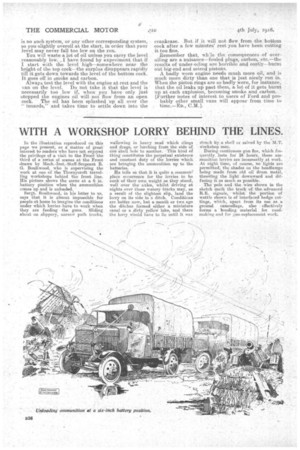WITH A WORKSHOP LORRY BEHIND THE LINES.
Page 14

If you've noticed an error in this article please click here to report it so we can fix it.
In the illustration reproduced on this page we present, as d matter of great interest to readers who have riot enjoyed the privilege of a visit to the Front' the third of a series. of scenes atthe Front drawn by Mech.-Inst.-Staff-Sergeant B. G. Boultwood, who is supervising the work at one of the Thorn,yeroft travelling workshops behind tho front line. His picture shows the scene at a 6 in. battery position when the ammunition cranes up and is unloaded. • •
Sergt. Satinwood, in his letter to us, says that it is almost impossible for people at home to imagine the conditions under which lorries. have to work when they are feeding the guns. Sliding about on slippery, narrow path tracks, wallowing in heavy mud which clings and drags or lurching from the side of
one shell drags, to another. This kind of thing constitutes the perpetual existence and constant duty of the lorries which are bringing the ammunition up to the batteries.
He tells us that it-is quite a common: place occurrence for the lorries to be sunk of their own weight as they stand, well over the axles, whilst driving at nights over these watery tiacks may, as a result of the slightest slip, land the lorry on its side in a ditch. Conditions arc better now, but a, month or two ago the ditches formed either a Miniature canal or a dirty yeiloar lake, -and there the lorry would have to lie until it was struck by,a shell ut salved by the MT. Workshop men, • Dnring continuous gun fire, which frequently lasts for24." hours, these amMunition lorries arc incessantly at work. At night time, of course, no lights are permitted, the shades on the headlamps being made from old oil drum. metal, throwint, the light' doWnWard and diffusing it as much as' pessible. The pole and the wire shown in the sketch mark the track of the advanced R.E. signals, whilst the portion of • wattle shown is of' interlaced hedge cutting-, which, apart from its use as a ground camouflage, also effectively forms a bonding material for roadmaking and for gen-replacement work.






















